Collaboration
Getting multiple inputs to a bid in time for a submission deadline was difficult enough when people worked in the same office, but now that most people are working remotely and there are no face-to-face conversations, it has become even harder.
To overcome this, it is important to have an easily accessible register of files and not rely on a system which is limited (by permission or capability) to a select few.
Microsoft Teams might be a help or a hinderance.
Reviewers’ Tips
As a bid reviewer, it is important that you add value to the document and invest your own time wisely.
There is no point in just looking for typos or critiquing the quality of graphics if the underlying content is weak or sections have been omitted.
It is always worth preparing for a review by reminding yourself of the client’s requirements, your own offering and the key messages you want to convey.
Starting Point
It can be very tempting to simply re-use text which was given good feedback in a previous tender.
While the old text might contain relevant information, it is unlikely that it will fully answer the question in the context of the contract you are now tendering.
A better approach is to start with an outline plan which identifies what is needed and then paste pre-written text in where appropriate.
Bid Burnout
In the run-up to a submission deadline, bid writers often work long hours and experience high levels of pressure.
The responsibility for producing a winning bid should be shared within a company and not all left with the person or people who compile it.
Acknowledging the shared roles can help avoid people becoming stressed and overwhelmed.
Bid / No Bid Decision
With an avalanche of opportunities and limited resources, it is vital that you take informed bid / no bid decisions.
Rather than bidding for anything you ‘can do’, you should ensure you target the ones you ‘can win’.
The process for deciding what is winnable should be developed based on your own company experience.
Pitch Preparation
Virtual presentations are more tricky than in-person ones and will likely require more preparation time.
Think carefully about the handovers between speakers because normal visual cues and body language will not be possible.
Also consider how you will deal with general discussion to avoid appearing to interrupt each other.
Version Control
When things are getting a bit fraught in the final stages of a tender submission, it is easy for document control to slip.
It is vitally important that you maintain naming conventions and filing standards to avoid mishaps.
Set up your systems at the outset and ensure everyone adheres to them to avoid overwriting, incorrect attachments or rework.
Remote Teams
If your bid team is working remotely it can be very difficult to maintain momentum and motivation.
While interruptions are not ideal, it is essential that you all stay in touch and bounce ideas around to achieve consistency in the response.
Think about the ways you would communicate in the office and try to replicate them for home workers.
Health and Safety Responses
Where you are asked about Health and Safety, you should convey ‘understanding’ and ‘adherence’.
The best response will usually be one which provides specific details and doesn’t just refer to a company procedure.
Try to keep your response practical (rather than theoretical) by linking it to the actual work whenever possible.
Read The Documents
When you receive invitation to bid documents from a client it can be tempting to skim through them, particularly if there are numerous files.
The danger of doing this is that you miss a requirement and therefore are not compliant in your final response.
Examples of things which are easily missed include tender declarations, community benefit templates and innovation invitations.
Contingency Planning
Where you are asked about business continuity, it may be tempting to focus on your recent experience of disruption due to COVID.
While it might be useful to cite this as an example, the client will be interested in all aspects of business continuity.
Your response should cover areas such as data security, office integrity and succession planning as well as audit procedures.
Identifying Opportunities
Many companies receive bid and tender opportunities through alert systems or directly from customers.
To stay one step ahead of the competition, you should supplement these channels by contacting potential customers who have been identified through market intelligence.
Furthermore, where you proactively seek out work, you have the potential to negate the requirement for a tender process.































































